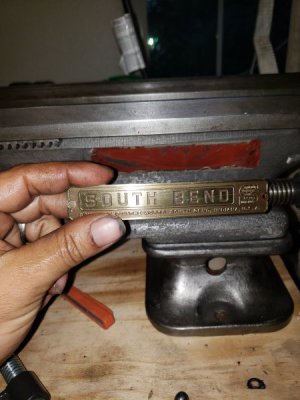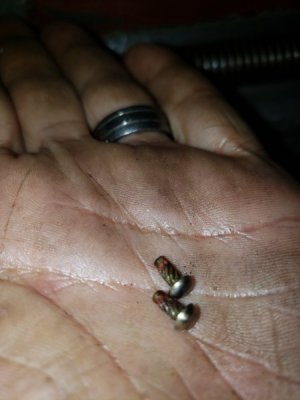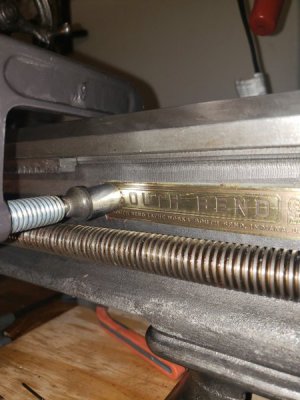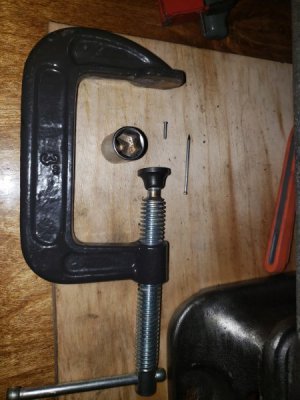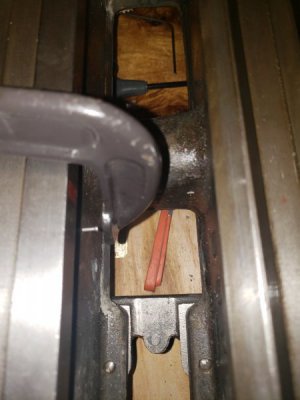- Joined
- Sep 22, 2010
- Messages
- 7,222
If you want to paint the machine or restore the nameplates on a piece of used machinery, you often need to remove the nameplates intact as possible.
How would you do that? Here are some popular methods- please add your feedback.
Best,
Nelson
-------------------------------------------
1. If the plate is attached to a sheet metal part or other application with a through-drilled hole, just punch out the drive screw from the back. Hardinge lathe cabinet doors are an example of this application.
2. If the drive screw is in a blind hole, the head needs to be pulled out at least a few thousandths. Then you can grip it with pliers and pull and twist. There are three ways to get the drive screw started out a little bit.
a. Use a diagonal flush-cutting plier to wedge the drive screw out of the hole. These cutters are designed for plastic ties and copper wire, so the delicate cutting edge will get notched when it is used on a hardened steel drive screw. But it will usually get the job done. You might need to use method b or c before you can get the dikes to catch under the screw head. You can convert an old pair of dikes to flush-cutting by grinding the jaws down flat on the working side.
b. Use a cold chisel with a custom-ground edge (single bevel, like a wood-working chisel. This acts like one half of the flush-cutting dikes, and you have to be careful not to go too far and cut off the screw head.</font>
c. Use a sharp knife with disposable blades, like an Exacto or a utility knife. Force the blade under one side of the screw head until the edge hits the screw body.
Brass plates usually are pretty easy to get off without damage. Aluminum is more likely to get a little damage (scratch and dent) where the tool pressure is applied. Plastic plates (1940's Hardinge) are very fragile at the corners next to the screw hole.
After repainting the machine, tap the blind holes and attach the plates with machine screws.
Another method:
Use a dremel tool with a cutoff blade that cuts a slot for a screwdriver. They either back out easily with the screwdriver or the head breaks off cleanly, and if that happens the plate just slides off and there is enough of the shank left to grab with a pair of pliers to remove the rest.
-------------------------------------------
How would you do that? Here are some popular methods- please add your feedback.
Best,
Nelson
-------------------------------------------
1. If the plate is attached to a sheet metal part or other application with a through-drilled hole, just punch out the drive screw from the back. Hardinge lathe cabinet doors are an example of this application.
2. If the drive screw is in a blind hole, the head needs to be pulled out at least a few thousandths. Then you can grip it with pliers and pull and twist. There are three ways to get the drive screw started out a little bit.
a. Use a diagonal flush-cutting plier to wedge the drive screw out of the hole. These cutters are designed for plastic ties and copper wire, so the delicate cutting edge will get notched when it is used on a hardened steel drive screw. But it will usually get the job done. You might need to use method b or c before you can get the dikes to catch under the screw head. You can convert an old pair of dikes to flush-cutting by grinding the jaws down flat on the working side.
b. Use a cold chisel with a custom-ground edge (single bevel, like a wood-working chisel. This acts like one half of the flush-cutting dikes, and you have to be careful not to go too far and cut off the screw head.</font>
c. Use a sharp knife with disposable blades, like an Exacto or a utility knife. Force the blade under one side of the screw head until the edge hits the screw body.
Brass plates usually are pretty easy to get off without damage. Aluminum is more likely to get a little damage (scratch and dent) where the tool pressure is applied. Plastic plates (1940's Hardinge) are very fragile at the corners next to the screw hole.
After repainting the machine, tap the blind holes and attach the plates with machine screws.
Another method:
Use a dremel tool with a cutoff blade that cuts a slot for a screwdriver. They either back out easily with the screwdriver or the head breaks off cleanly, and if that happens the plate just slides off and there is enough of the shank left to grab with a pair of pliers to remove the rest.
-------------------------------------------

